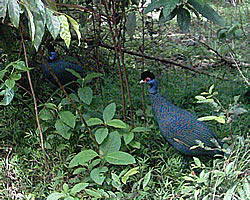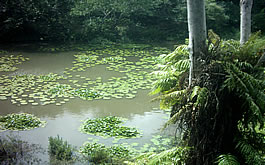|
Country Info
....................................................................................................................................
The Kenyan Coastline

Kwale - Shimba Hills
The South coast is more peaceful than the North coast and has
noticeably cleaner beaches. So if you want to get away from the
crowds this is perfect for you! The road heading further south
towards Tanzania is framed by mile after mile of palm and coconut
tree plantations.
If you are after adventure with camping thrown into the bargain
there is a vast expanse of gently rolling hills with scrub bushland
in the Kwale and Shimba Hills area. This was the setting for a whole
new experience with nature for me- no electronic devices, no mobile
network, just me and nature.
Mwaluganje Elephant sanctuary
About ten minutes from the ferry is a road leading right to this
sanctuary. Signs will lead you on through thick forests and over
terrain which most wouldn't imagine can exist in the coast. Entry to
the Park requires a reasonable entry fee, which supports the local
community. From the main park gate it takes about half an hour to
get to the camp itself. Please listen closely to the directions
given to you as they are based on certain stones lying on the ground
in certain corners with certain numbers indicated. Suffice it to say
we begun to panic as the sun begun to set. It didn't help matters
that we met elephants just 30 seconds after getting back into the
salon car which couldn't go up a slope with us in it.
So on we drive and suddenly at this corner looms a massive
elephant head. Now that wouldn't be so bad except that the road
behind us was so uneven that we couldn't reverse, plus we were in a
saloon car, plus the elephant got agitated on seeing our camera-
apprently it looks like a gun and elephants remember the poaching
days very clearly. To cut a long story short it finally got bored
after its friend came, gave us one look and moved on. On to the camp
with beating hearts and prayers rapidly said....
Legend has it that Mwaluganje elephant camp was named after the
Luganje family that owned the miles of acres on which the camp
stands.
Trips to the camp are organized by the Travellers group of hotels
– Travellers beach in North coast and Travellers Tiwi in South
Coast.
If you enjoy adventure in the wild this camp is perfect. Facing a
traditional elephant trail, it allows guests to watch the elephants
from the comfort of their luxury tents, each with its own private
verandah, shower, comfortable furnishings and power supply.
The traditional evening campfire is the highlight of the day.
Over a cool drink watch the Maasai light fire the traditional way
using elephant dung and wood called Oiti in
Kimaasai, enjoy traditional Maasai dances- it looks so easy when
they do it! And listen to Mijikenda folk stories and dances. And
lastly get a free Kiswahili lesson – did you know that white wine is
called Mvinyo Mweupe in Kiswahili? I didn't.
Activities - game drive
After a peaceful night wake up to a game drive before breakfast,
one of the best times to catch animals in action. The south coast is
home to vast numbers of animal and bird species, so a visit to any
sanctuary such as this will surely reward you with sightings of
elephants, the elusive warthog and Lilac-breasted rollers.
|
Some interesting facts about
Elephants:-
- the African elephant is the largest living
land mammal, living upto 60 or 70 years.
- Its muscular trunk is a remarkable feature
that serves as a nose, a hand, an extra foot, a signaling
device and a tool for gathering food, for dusting, digging
and tearing down trees or fighting.
- Elephants don't drink with their trunks
but use them as "tools" to drink with. They do this by
filling the trunk with water and then using it as a hose to
pour it into the elephant's mouth.
|
And when you finally make it back for breakfast you can enjoy the
spectacle of elephants gathering at the waterhole down below, after
which they dust themselves with dust to keep off flies.
 Guinea Fowl Guinea Fowl
Shimba Hills
 The road that begins as tarmac and ends as murram is still
good enough for saloon cars, as we drive a mere 45 kilometres away
from the ocean to the Shimba hills. Slightly humid and covered in
green vegetation it is home to the Shimba Hills lodge, a wooden tree
lodge overlooking a waterhole in the middle of a tropical
rainforest. The road that begins as tarmac and ends as murram is still
good enough for saloon cars, as we drive a mere 45 kilometres away
from the ocean to the Shimba hills. Slightly humid and covered in
green vegetation it is home to the Shimba Hills lodge, a wooden tree
lodge overlooking a waterhole in the middle of a tropical
rainforest.
Kwale district is inhabited by the Akamba, Digo and
Duruma tribes and contains huge amounts of titanium that have caused
quite some issues over the past few years. It is also home to huge
numbers of wildlife, including big cats.
The atmosphere is cool and relaxing, some tourists
have even chosen to hold their weddings here. Aside from the trees
growing through the lodge, there also exist plants that date back to
the Jurassic or dinosaur age, like the Cycad. And
beside it lounge some monitor lizards.
The lodge's 30 rooms and lounge areas all have
balconies overlooking the watering hole, above which a pair of fish
eagles stealthily wait to pounce on their prey. To help them along
bread is thrown into the water, luring the fish to the surface to
nibble on it, until suddenly the eagle swoops and cleanly nets one
in its claws.
Coastal red-bellied squirrels are lured to the
dining area, hoping to get a few crumbs from generous guests.
Activities
An afternoon game drive in the Shimba National
Reserve is a must-do activity here, because this is the last
remaining habitat of the Sable antelope in East
Africa .
Fortunately they are the first animals we come
across, one adult male watching over the mostly female herd. Males
turn black at 4 years of age after which they are kicked out of the
herd by the dominant male. Females eventually darken too as they
age, their age indicated by the number of rings on their horns.
Something unique about these animals is that the male takes an
active role in rearing the offspring. Also, they fight for territory
rather than for females, because the richer the territory the more
the females who will automatically be drawn to it. Forest soils are
naturally deficient in the quantities of minerals needed by these
animals, so Sables supplement their mineral intake by a process
called ‘osteofergia', which means ‘the chewing of bones'. They
search for territories with elephant graveyards in which they chew
the dead elephants' bones to take in the supplementary minerals.
Close by we see two male Maasai giraffe browsing,
and our naturalist tells us of their sad fate. Apparently for quite
some time there have been only three male giraffes in this reserve,
absolutely no female, and this presents a major problem during the
mating season. Unfortunately the same goes for a lone female ostrich
here. Hopefully this will be resolved soon otherwise their species
here will surely die off within this reserve.
The Shimba Reserve is 75% forest and 25% open
clearing, so chances of seeing animals are higher on the clearing.
As in most parks and reserves that we have visited, elephants are in
plenty.
If you want a guide to accompany you so that you
can get those extra bits of information you may ask for one at the
main gate. Otherwise many tourists simply hire a vehicle and find
their way through.
Accommodation rates and
images
The Kenyan coastline:-
| 


